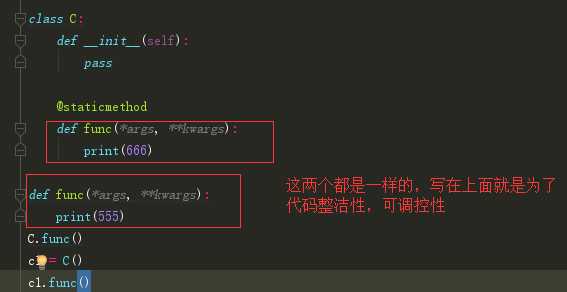标签:dict *args 技术 local src 对象 print show div
# 类方法:
class B: country = ‘China‘ # 静态变量(属性,字段) def func(self): # 动态普通方法 pass def __init__(self,name,age): # 特殊方法:双下方法 self.name = name @classmethod # 类方法 def func2(cls): # print(cls) cls.area = ‘东北‘ cls.name = ‘狗哥‘ print(B) print(B.__dict__) B.func2() print(B.__dict__)

# 练习:检测一下我示例化了多少个对象。
# 类方法:必须通过类的调用,而且此方法的意义:就是对类里面的变量或者方法进行修改添加。
class C: count = 0 def __init__(self): C.cou() @classmethod def cou(cls): cls.count += 1 # obj = C() obj = C() obj = C() obj = C() obj = C() obj = C() obj = C() obj = C() obj = C() obj = C() obj = C() print(C.count) #11
# 静态方法:
# 静态方法: 就是一个不依赖类以及对象的一个普通函数,为什么在类里面?
# 为了保证代码的一致性,可调控性,整洁性。
举个例子:
class C: def __init__(self): pass @staticmethod def func(*args, **kwargs): print(666) def func(*args, **kwargs): print(555) C.func() c1 = C() c1.func()


import time class TimeTest(object): def __init__(self, hour, minute, second): self.hour = hour self.minute = minute self.second = second # 各种方法 @staticmethod # 静态方法 def showTime(): return time.strftime("%H:%M:%S", time.localtime()) def showTime(): return time.strftime("%H:%M:%S", time.localtime()) print(TimeTest.showTime()) t = TimeTest(2, 10, 10) nowTime = t.showTime() print(nowTime)

标签:dict *args 技术 local src 对象 print show div
原文地址:https://www.cnblogs.com/wangkaiok/p/9988051.html